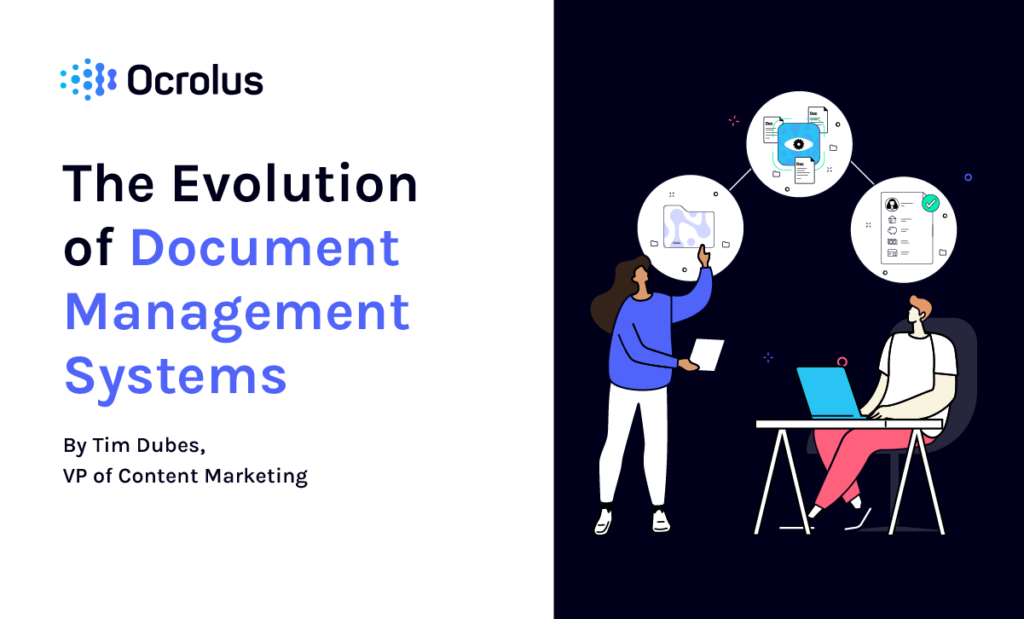The Evolution of Document Management Systems

For years, businesses survived solely on paper records and trust. Gradually, as electronic document storage became more easily accessible, it became the norm for maintaining documents. Today, we’re on the cusp of yet another leap in document management systems; capture to insight. Let’s dive into the evolution of document management and document digitization.
Document Management Systems Evolution
Document management has evolved over the decades. While the world has been managing documents electronically since the seventies, things really took off in the eighties when document scanning became mainstream. This process, in which organizations captured documents primarily for records management, was called capture-to-archive.
This method delivered measurable benefits as companies used it to escape from an ocean of paper. It reduced storage costs and enabled organizations to back up documents more easily. It also made research more efficient by letting employees quickly retrieve documents.
However, this generation of document management only took companies so far in their quest for efficiency. Organizations typically only used document digitization towards the end of a document’s lifecycle, when the focus switched to keeping information for reference. While this saved employees time rifling through paper archives, they still found themselves shuffling paper when working on current tasks.
Since then, we’ve seen upgrades in document management tools and techniques, fueled by better storage, increasingly open software, and more recently, a dramatic increase in computing power.
Document Management: Records to processes
The nineties is where the second generation of electronic document management, called capture-to-process, came into play. It shifted the digitization of documents earlier in their lifecycle, enabling employees to use the electronic versions in everyday tasks.
This accelerated the benefits of document digitization. Scanning documents and recognizing their text slashed data entry times, reduced workflow queues, and lowered document-driven process costs. Sending documents electronically also made it possible to share them more quickly for approval, accelerating and automating business processes.
This generation of document management was able to be used in industries that had struggled for years with cumbersome paperwork, placing document management technology squarely in the mainstream. New applications included everything from invoice processing to the approval of insurance policies and the processing of claims.
Capture-to-process also integrated with records management to help with legal and compliance applications. Now, companies could further utilize electronic document storage and store digitized documents with their associated process metadata, creating a record of their usage. This made things easier for compliance departments, who now had access to more detailed document usage and audit records, including source documents in digital form.
A new era of AI-driven document management and analysis
The last major upgrade for document management and analysis has only come in the past couple years. Advances in computing, including graphics processors and cloud infrastructure, made long-envisioned artificial intelligence capabilities practical for the first time. Rudimentary capabilities like optical character recognition had been in use for a while, but machine learning has taken that ability to a whole new level. Applications can now ‘read’ documents at speed, ingesting their information and even applying natural language recognition and semantic AI-driven document analysis techniques.
This enhanced capture-to-process’ operational capabilities and gave us the next generation of document management: capture to insight. Through this process, businesses can automate the analysis of transactional documents en masse, allowing them to digest potentially millions of documents and create data collections that AI can then trawl for notable patterns.
As AI-based analytics surface usable insights, companies can then use them to adapt their workflows and optimize models governing everything from pricing to risk.
Every generational development in document management has bought new benefits, and this latest evolution is no exception. It unlocks the value of proprietary data, which companies can now mine in aggregate for new knowledge. In addition, it gives businesses the ability to streamline existing services and potentially create entirely new service elements.
We’re seeing this new generation of document management being utilized in many new ways, including retrospective analysis, in which clients extract data from historical documents and use it to identify patterns. They then use this to build business intelligence models.
For example, one financial services company that Ocrolus worked with was able to extract and process data from over a million bank statements, mapping it against the performance of its loans. It was then able to optimize its pricing and risk models.
Capture-to-insight drives benefits beyond operational processes into strategic improvement. It also opens up the user base. Document management tools started by targeting archivists, and later management staff. Now, it targets the C-suite, giving decision-makers the capability to analyze decades of documents for insights. As companies wake up to the possibilities delivered by modern document management systems, the possibilities to scale and optimize their current business models become practically endless. To learn more about today’s modern industry terms related to document management, automation, and more, visit our Glossary.
Ocrolus is an industry leader in the capture to insight process and has allowed financial institutions to both analyze and recognize patterns in their own data in completely new ways. We give companies the ability to become empowered by their own data. Ready to see how? Schedule a demo to learn more about our document automation software.




